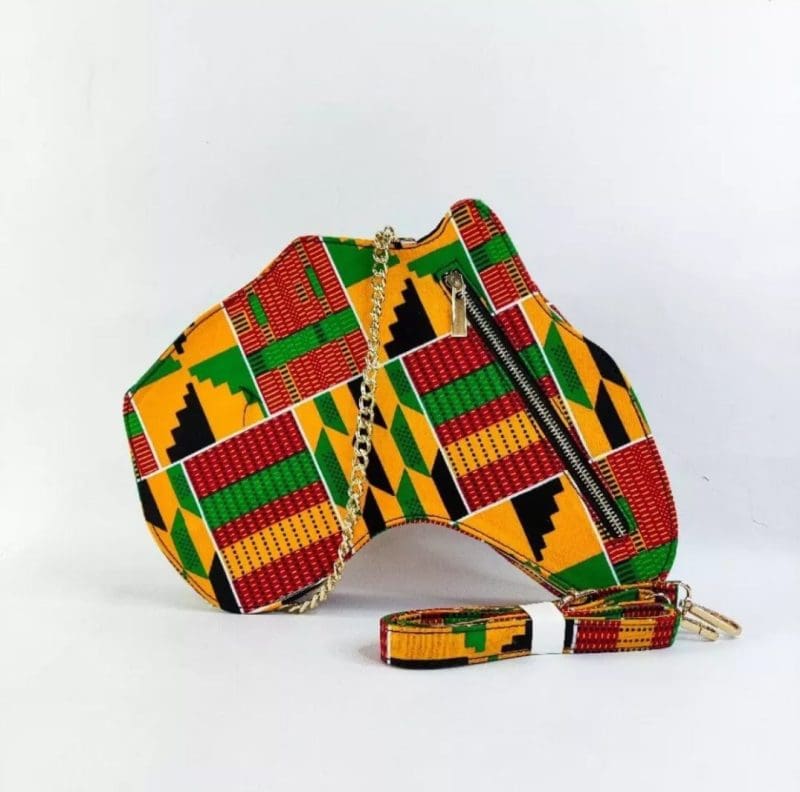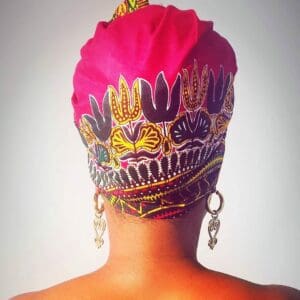
Most of us have walked along a high street somewhere in the world and spotted a bold print, unlike anything you have ever seen. With bright colours and gorgeous patterns, you probably asked yourself “where can I get something like that?“
Well, my friend, those are unique African prints, and they hold a much deeper meaning than just jazzing up your favourite outfit.
Afrocentric fashion is a colourful and culture-rich fashion style that can be found all over the world. Once you understand more about the African cultures and the history that contribute to these beautiful, bold designs, you’ll find them even more alluring!
What do African prints mean, though? Let’s delve into the significance of some of them through their histories in their countries of origin.
What are African Wax Prints?
An African wax print is a bright, patterned print made on cotton fabrics using a wax-resist dyeing technique. In genuine wax printing, wax gets melted and applied by hand to the material, which is then dyed in a striking hue. This wax-and-soak process is repeated many times.
African wax printing is made from 100% cotton cloth and known for bold and vibrant designs in different geometric shapes or floral patterns. Wax printing is used on a variety of different clothing items and accessories. These include dresses, shirts, trousers, skirts, headwraps and various types of bags.
The method of creating African Wax Prints is called Batik which originates from Indonesia. When the Dutch colonised Indonesia they took this method back to the Netherlands and mass-manufactured fabrics using machines to imitate the authentic design. However, Due to the lack of authenticity, it was not well-received in Indonesia.
Kente
Kente patterns incorporate coloured shapes woven together in differing blocks or bands. The pattern originates from the traditional Kente cloth, which is handwoven cotton or silk fabric conceived in Ghana in the 1600s.
The Ashanti, or Asante tribe, was responsible for the original Kente fabric. According to Ashanti legend, a pair of hunters stumbled upon a huge spider spinning a spectacular web. Amazed by the web’s beauty, they decided to create a version of it themselves, and Kente was the result.
The hunters presented what they had made to the king of the Ashantis, and Kente was immediately adopted as the material of Ashanti royalty.
You make authentic Kente cloth by weaving colourful cotton fabric strips together into shapes, stripes or different textures using a wooden loom. After that, these combined strips are sewn together to create complex woven material.
In modern times, Kente cloth is a huge player in Afrocentric fashion for women all over the world. Kente cloth patterns are often utilised as female clothing trims to accentuate necklines, hems and sleeves.
Scarves, headwraps and t-shirts are also made using Kente patterns, as are these handmade cufflinks on sale at Wakuda. Continuing the Kente theme, you can also find a pack of four Kente coasters and a blue orange kente high headwrap card if you wish to send a Kente gift to a special someone in your life.
Dashiki
The Dashiki is a loose, long-flowing V-neck shirt worn by West African men. It was popular with the Civil Rights movement in the US during the 1960s and 70s.
While the brightly coloured Dashiki was traditionally a long garment worn by men, these designs are now found on many other items of clothing. Take a look at the Pink Dashiki Headwrap on sale at Wakuda, for example. It’s also used for dresses, caftans, tunics and pant-suits for women.
Dashiki African print is still synonymous with unity and Black pride. The word itself comes from the Yoruba word “dàṣíkì,” literally meaning “shirt.”
The exact origin of the African fabric is not clear, although it has been made and worn all over West Africa for centuries. Many believe Dashiki originated in one of the West African countries, most likely Ghana or Nigeria.
Dashiki fabric is traditionally handmade and incorporates weaving or printing. It is usually made using cotton or silk, with plenty of shapes and symbols included in the print. While most Dashiki prints are very bright, there are also more toned-down versions.
Ankara
Ankara is the most well-known type of African wax printing. It is the wax printing you most often see on current women’s clothing all over the world.
The entire cloth is covered in intricate prints made from melted wax. These get applied to the material and then soaked in dye for the final effect.
Ankara is also known as Dutch wax printing which is what we referred to earlier as African wax printing. Despite this technique of wax printing originating in Indonesia, it gained the name African Wax Prints when African soldiers took this technique back to their home and popularised it by adding bright, vibrant colours to the geometric patterns. The rest, as they say, is history.
Ankara prints are highly valued for their beauty and cultural significance. They’re worn all over the world to celebrate and promote African culture, fashion and heritage.
Ankara is not only used in women’s dresses but also in several other creative and innovative ways. Examples are the Table Runner & Napkin Set and the African Ankara Print Handheld Folding Hand Fan on sale at Wakuda. One of our most prolific Ankara-style brands is My Ankara Love, renowned for its range of Ankara lampshades.
Mudcloth
As the name suggests, mudcloth was true “mud cloth” – it was made with actual mud!
The locals from 12th-century Mali’s Bamana culture used clay jars to ferment riverbed mud for months – even as long as a year. The result was a pigmented mud-brown colour that was used to pattern white material.
Modern mudcloth prints include angular black designs. These are imprinted on either white or single-coloured backgrounds.
Nowadays mudcloth is machine-produced, but originally men would use looms to weave strips of material. Once weaved, they’d stitch them together to form clothes. Women would then paint and dye the results.
Interesting circular, linear and other shapes decorated the material. Each pattern told a story which you could understand if you knew the meanings of the symbols. The “mud cloth” displayed the wearer’s status in the tribe, with many African women still taking immense pride in their mudcloth apparel.
Like many other African fashions, mudcloth includes sophisticated styles. The predominantly black and white colours differ vastly from the vivid hue you’ll find in other materials from the continent. On Wakuda, we’re privileged to feature Colourshot, a brand selling a number of mud cloth-inspired items. These include a pack of four headwrap cards and mudcloth-inspired gift wrap.
Conclusion
At Wakuda, we’re looking to bring a little bit of Africa to you through our range of different brands and products incorporating an array of African-styled prints. For any other Afrocentric fashion items that you might be looking to buy or sell, or any other questions you might have, feel free to contact us. We’ll do our very best to help!











